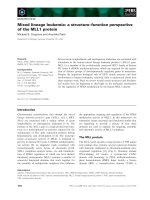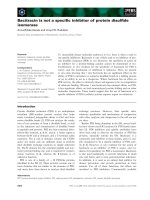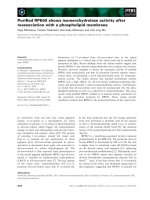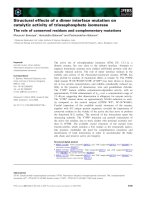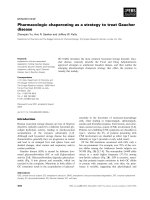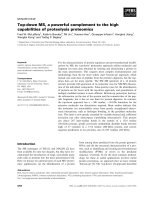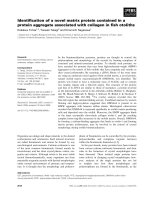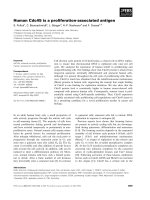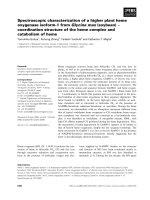Báo cáo khoa học: Planarian peptidylglycine-hydroxylating monooxygenase, a neuropeptide processing enzyme, colocalizes with cytochrome b561 along the central nervous system pptx
Bạn đang xem bản rút gọn của tài liệu. Xem và tải ngay bản đầy đủ của tài liệu tại đây (815.16 KB, 14 trang )
Planarian peptidylglycine-hydroxylating monooxygenase,
a neuropeptide processing enzyme, colocalizes with
cytochrome b
561
along the central nervous system
Akikazu Asada
1
, Hidefumi Orii
1
, Kenji Watanabe
1
and Motonari Tsubaki
1,2,3
1 Department of Life Science, Graduate School of Life Science, University of Hyogo (formerly Himeji Institute of Technology), Hyogo, Japan
2 CREST, Japan Science and Technology Agency (JST), Saitama, Japan
3 Department of Molecular Science and Material Engineering, Graduate School of Science and Technology, Kobe University, Hyogo, Japan
Neuropeptides in the brain, in the nervous system, and
in various endocrine cells are synthesized in the rough
endoplasmic reticulum as large precursor proteins. After
transit to vesicles and during axonal transportation
along axons, several processing enzymes residing in the
vesicles process the peptides to convert them to mature
forms. C-terminal a-amidation of the peptides occurs in
the late stage [1] and is probably a rate-limiting step in
many instances [2]. Over half of peptide hormones or
neuropeptides are amidated in vertebrates; in insects,
greater than 90% of such peptides show the presence of
a C-terminal amide moiety [3]. This C-terminal amide is
very important in their functions, as its absence often
disrupts the activity or receptor-binding properties of
the peptide ligands [4]. Indeed, most neurotransmitters
thus far identified are amidated peptides in cnidarians
Keywords
peptidylglycine a-hydroxylating
monooxygenase; cytochrome b
561
;
planarian; neuroendocrine vesicle;
neuropeptide amidation
Correspondence
M. Tsubaki, Department of Molecular
Science and Material Engineering, Graduate
School of Science and Technology, Kobe
University, Rokkodai-cho, Nada-ku, Kobe,
Hyogo 657-8501, Japan
Fax: +81 78 803 6582
Tel: +81 78 803 6582
E-mail:
Note
The nucleotide sequence of planarian PHM
in this article has been submitted to the
DDBJ ⁄ EMBL ⁄ GenBank databases with
accession number AB195502.
(Received 27 September 2004, revised 2
December 2004, accepted 14 December
2004)
doi:10.1111/j.1742-4658.2004.04528.x
Planarians are one of the simplest animal groups with a central nervous
system. Their primitive central nervous system produces large quantities
of a variety of neuropeptides, of which many are amidated at their
C terminus. In vertebrates, peptide amidation is catalyzed by two enzymes
[peptidylglycine a-hydroxylating monooxygenase (PHM) and peptidyl-a-
hydroxylglycine a-amidating lyase] acting sequentially. In mammals, both
enzymatic activities are contained within a single protein that is encoded
by a single gene. By utilizing PCR with degenerate oligonucleotides derived
from conserved regions of PHM, we succeeded in cloning a full-length
cDNA encoding planarian PHM. The deduced amino acid sequence
showed full conservation of five His residues and one Met residue, which
bind two Cu atoms that are essential for the activity of PHM. Northern
blot analysis confirmed the expression of a PHM mRNA of the expected
size. Distribution of the mRNA was analyzed by in situ hybridization,
showing specific expression in neurons with two morphologically distinct
structures, a pair of the ventral nerve cords and the brain. The distribution
of PHM was very similar to that of cytochrome b
561
. This indicates that
the ascorbate-related electron transfer system operates in the planarian cen-
tral nervous system to support the PHM activity and that it predates the
emergence of Plathelminthes in the evolutionary history.
Abbreviations
AsA, ascorbic acid; CNS, central nervous system; DBH, dopamine b-hydroxylase; DBHL, dopamine b-hydroxylase-like protein; PAL, peptidyl-
a-hydroxylglycine a-amidating lyase; PAM, peptidylglycine a-amidating monooxygenase; PHM, peptidylglycine a-hydroxylating
monooxygenase; MDA, monodehydroascorbic acid; TBH, tyramine b-hydroxylase; VNC, ventral nerve cords.
942 FEBS Journal 272 (2005) 942–955 ª 2005 FEBS
(coral, jellyfish, sea anemones), which possess the most
primitive form of nervous system, suggesting that the
archetype nervous systems may have relied on amidated
peptides [5]. The C-terminal a-amidation of neuro-
peptides is catalyzed by two enzymes: peptidylglycine
a-hydroxylating monooxygenase (PHM; EC 1.14.17.3)
and peptidyl-a-hydroxyglycine a-amidating lyase (PAL;
EC 4.3.2.5) consecutively [4,6,7]. In vertebrates, PHM
and PAL are expressed together within one polypeptide
chain and denoted as peptidylglycine a-amidating mono-
oxygenase (PAM) [8–10]. In some animals, such as
Drosophila [11] and Calliactis [12], PHM is encoded by a
distinct gene. In the mollusc, Lymnaea, a multifunctional
PAM containing four different copies of PHM and a
single PAL has been found [13]. Endogenously, this
zymogen was converted to yield a mixture of mono-
functional isoenzymes. However, in the nematoda,
Caenorhabditis elegans, both types of enzyme are pre-
sent, based on analyses carried out using the SMART
web-based resource ( />[14].
Planarians – nonparasitic free-living flatworms of
the phylum Plathelminthes, class Turbellaria – are
phylogenetically very distant from vertebrates but have
acquired a central nervous system (CNS), mesodermal
tissues, and a bilateral structure during evolution
[15]. Planarians use neuropeptides [16,17] as major
neurotransmitters. Planarian neuropeptides (substance
P-, FMRFamide-related peptides) are extensively
a-amidated [16–19], as observed in other invertebrates.
Therefore, it is of interest to examine which form
(PAM, PHM, or a different form) does exist in planar-
ians to characterize their primitive CNS as the puta-
tive ancestor of the sophisticated CNS of higher
animals.
The monooxygenase reaction catalyzed by PHM (or
the PHM domain) requires copper, ascorbate, and
molecular oxygen, as found for its close family mem-
ber, dopamine b-hydroxylase (DBH) [2]. Ascorbic acid
(AsA), which is accumulated in a relatively concentra-
ted manner inside the neuroendocrine secretory vesicles
[20], is converted to monodehydroascorbic acid
(MDA) radical after supplying the electron equivalent
to the catalytic copper center of the enzyme. As there
is no transmembrane transport of AsA or MDA rad-
ical in the vesicles [21], it has been postulated that
a common transmembrane electron carrier, cyto-
chrome b
561
, conveys a reducing equivalent from the
extravesicular AsA to the intravesicular MDA radical
[21–27]. Cytochrome b
561
, first observed in chromaffin
vesicles of bovine adrenal medullae [28,29] and later
found to be distributed in many neuroendocrine tissues
[30–33], is structurally and functionally very different
from other cytochromes [34]. It spans the vesicle mem-
brane [35] and has a favorable midpoint potential for
interacting with AsA and the MDA radical [36–39].
Very recently, we have succeeded in cloning the
planarian cytochrome b
561
cDNA [40]. The cyto-
chrome b
561
gene product was specifically expressed in
the planarian nervous system [40], suggesting that the
AsA-related electron transfer system, which supports
amidation of the neuropeptide, might predate or coin-
cide with the emergence of the CNS in animals. Thus,
as the second objective of our present study, we exam-
ined the colocalization of PHM with cytochrome b
561
in the planarian.
In the present study, we successfully accomplished
the two objectives raised above, namely we obtained
an entire planarian PHM cDNA and identified its spe-
cific expression in the planarian CNS as being colocal-
ized with cytochrome b
561
.
Results
Cloning of planarian PHM
By using degenerate oligonucleotide primers (PAM-
S4 ⁄ PAM-A3) (Fig. 1) coding for the conserved region
of PHMs of various animals, we cloned a 265 bp PCR
product from a cDNA library of the head portion of
the planarian. The deduced amino acid sequence of the
PCR product (67 amino acid residues, excluding the
primer regions) was highly homologous (containing 10
fully conserved amino acid residues) to other PHMs
and therefore consistent with a partial sequence of the
planarian PHM cDNA. To obtain a longer nucleotide
sequence, we carried out nested PCR on the first-
strand planarian head cDNA by using new specific
primers (spPAM-S2 and spPAM-S3) and SK20 vector
primer and a universal primer. A PCR product
( 560 bp) was cloned and sequenced. The clone was
found to encode the 3¢ end of the PHM cDNA, inclu-
ding a stop codon (TAG), the 3¢ untranslated region
(3¢-UTR), and the poly(A
+
) tail. Stepwise dilution
screening of the planarian head cDNA library by PCR
using two specific primers (spPAM-S3 and spPAM-A3;
PCR probe size, 144 bp) was then conducted. One
plaque was screened, in vivo excised, recloned, and
sequenced completely. This clone ( 1300 bp) was
found to encode a major part of the planarian PHM
gene, except for the NH
2
-terminal region. Several
cycles of PCR cloning, using specific primers (PPHM-
A4, PPHM-A3, and PPHM-A5) and vector primers,
followed by sequencing, gradually narrowed the uncov-
ered 5¢ end region. Finally, the most 5¢ end PCR prod-
uct was obtained, cloned, and sequenced to identify an
A. Asada et al. Planarian PHM
FEBS Journal 272 (2005) 942–955 ª 2005 FEBS 943
in-frame stop codon (TAG) at the most 5¢ end and the
putative initiation codon (ATG) followed by an open
reading frame. To obtain the entire planarian PHM
cDNA, stepwise dilution screening of the planarian
head cDNA library with PCR was again conducted by
using two specific primers (PPHM-S4 and PPHM-A3).
One plaque, containing the entire planarian PHM
cDNA gene, was obtained, completely sequenced and
analyzed. The strategy used to obtain the planarian
PHM cDNA sequence is summarized in Fig. 1.
The whole planarian PHM cDNA (1384 bp) con-
tained a single open reading frame (1149 bp), which
was preceded by the 5¢-UTR of 87 bp and followed by
the 3¢-UTR of 127 bp and the first 21 nucleotides of
the poly(A
+
) tail (Fig. 2). This indicated clearly that
planarian PHM is coded in a gene separate from that
of PAL.
Northern blot
Northern blot analysis of total RNA from the asexual
planarian was carried out. The cDNA probe coding
for a major region of planarian PHM hybridized with
an mRNA giving a single band of 1.4 kb (Fig. 3),
being consistent with the expected size based on the
cloned cDNA. This result also confirmed that there is
no PAM-like gene (i.e. a fused gene with PHM and
PAL) in the planarian that will generate an mRNA of
4 kb, as found for vertebrate PAMs.
Deduced amino acid sequence of planarian PHM
The deduced amino acid sequence of planarian PHM
predicted a protein with a length of 382 residues
(Fig. 2) and a theoretical molecular weight of 43701.34.
A hydrophobic segment (13 amino acid residues) at the
N terminus satisfied the consensus rules for the signal
sequences, with a cleavage site most likely to occur
after amino acid 15, based on analyses conducted by
using SignalP WWW and PSORT WWW servers. An
adjacent propeptide, present in vertebrate PAMs (inclu-
ding human, rat, bovine and Xenopus) was absent, as
observed for molluscan PHM [13].
The deduced planarian PHM amino acid sequence
was compared with those of PHMs and PHM domains
of PAMs from several representative species (including
Schistosoma, Drosophila, Calliactis, C. elegans, rat,
bovine and human) by a multiple sequence alignment
(Fig. 4). Five histidine and one methionine residue in
the central portion of PHM were considered to bind
two Cu atoms (Cu
A
and Cu
B
, also termed Cu
H
and
Cu
M
, respectively), which are essential for the catalytic
reaction of PHM. These six residues (indicated by #)
were also conserved in planarian PHM (Fig. 4). Fur-
thermore, it is known that well-conserved Cys residues
form putative disulfide bonds to fix the tertiary struc-
ture of the PHM domain. Eight of the 10 cysteine resi-
dues were conserved in planarian-PHM, as found for
other PHM sequences (except for C. elegans-PAM)
and are marked with + in Fig. 4. Additionally, corres-
ponding amino acid residues to the residues shown to
interact with bound peptide–substrate, such as Arg240,
Asn316 and Tyr318 in rat PHM [7,41] were also con-
served in planarian PHM (marked with ! in Fig. 4).
Percentage amino acid identities between these repre-
sentative PHMs and PAMs were calculated for their
PHM core regions and then tabulated (Table 1). The
planarian PHM sequence showed around 40% amino
Fig. 1. Schematic representation of the cDNA coding for planarian peptidylglycine a-hydroxylating monooxygenase (PHM) and positions of
degenerate and specific primers used in the present study. The broad white bar and the two flanking small white bars represent the coding
region and the noncoding regions of the planarian PHM cDNA, respectively; whereas the two flanking broad lines outside indicate the k ZAP
II vector. The two gray boxes in the planarian PHM cDNA represent the conserved sequences [(P ⁄ V)FAFR(T ⁄ V)H(T ⁄ A)H for positions 231–
239 of human peptidylglycine a-amidating monooxygenase (PAM) and EMCN(F ⁄ L)Y(I ⁄ M ⁄ L) for positions 308–315 of human-PAM, respect-
ively], for which two degenerate primers (PAM-S4 and PAM-A3) were designed. The degenerate and specific primers used were indicated
by horizontal arrows above the planarian PHM cDNA. The PCR clones and partial cDNA clones obtained were indicated below the planarian
PHM cDNA in the order of nucleotide sequence determination from top to bottom. Arrows indicate the direction of nucleotide sequence
determination. PO8 indicates the M13 reverse primer.
Planarian PHM A. Asada et al.
944 FEBS Journal 272 (2005) 942–955 ª 2005 FEBS
acid identity with all the sequences listed in Table 1.
The closest similarity was found to Schistosomas PHM
(46.0%) and the most distant one was C. elegans PAM
(33.6%). To further understand the evolutionary rela-
tionship, we conducted a detailed phylogenetic analysis
of planarian PHM in comparison with other PHMs
or PHM domains and DBHs [including tyramine
b-hydroxylases (TBHs) and DBH-like proteins
(DBHLs)] from various animals (28 sequences in
total). The analysis showed that planarian PHM was
very distant from DBH, TBH and DBHL (Fig. 5). Pla-
narian PHM was classified as a member of a subfamily
consisting of PHMs from Drosophila, Heterodera,
C. elegans and Schistosoma and was distinct from
PHM domains of vertebrate PAMs and cnidarian
PHMs (Fig. 5).
Expression of PHM along the planarian CNS
The planarian CNS is basically constituted by an
anterior ‘brain’ and a pair of longitudinal ventral nerve
cords (VNCs) that run through the length of the body.
The expression of the planarian PHM gene, as shown
by in situ hybridization, was specific in these neurons
(Fig. 6A,B). The planarian cytochrome b
561
gene was
also expressed to a similar extent in the brain and in a
pair of VNCs (Fig. 6C,D), in accordance with our pre-
vious observation [40]. The pattern of gene expression
Fig. 2. Nucleotide and deduced amino acid sequences of planarian peptidylglycine a-hydroxylating monooxygenase (PHM). The nucleotides
are numbered from the 5¢ to the 3¢ end, and the amino acid residues are numbered starting with the first ATG in the open reading frame.
The translation termination codon is indicated by an asterisk. The sequence obtained by the first degenerate PCR is singly underlined,
whereas the sequences corresponding to the two specific primers PPHM-S1 and PPHM-A1, used for production of the PCR probe for the
Northern blot analysis, are underlined by broken lines.
28S
18S
cyt.b561 mRNA
1.4 kb
Fig. 3. Northern blot analysis of peptidylglycine a-hydroxylating
monooxygenase (PHM) mRNA in the planarian. A PCR probe pro-
duced by two specific primers – PPHM-S1 and PPHM-A1 – was
used for Northern blot analysis. Total RNA (10 lg) derived from the
whole planarian body was probed with the planarian PHM cDNA.
A. Asada et al. Planarian PHM
FEBS Journal 272 (2005) 942–955 ª 2005 FEBS 945
Fig. 4. Multiple alignment of peptidylglycine
a-hydroxylating monooxygenase (PHM) or
PHM-domain sequences of planarian,
Schistosoma, Drosophila, Calliactis, Caenor-
habditis elegans, rat, bovine and human ori-
gin. Amino acid residues common to all
sequences are denoted by asterisks below
the sequences, whereas conservative resi-
dues are indicated by colons (:) or a full stop
(.). The five His and one Met residue that
form complexes with two Cu
2+
atoms are
indicated by # in the uppermost line,
whereas eight conserved Cys residues that
form four putative Cys-Cys disulfide bridges
and three conservative residues that might
interact with the bound peptide substrate
are marked with + and !, respectively. The
sequences were obtained from S. mansoni
(Schistosoma-PHM; AY172995), Drosophila
(Drosophila-PHM; AY069103), Calliactis (Cal-
liactis-PHM; AF036337), C. elegans (C.ele-
PHM; AC025726 and C.ele-PAM; U80438),
rat (Rat-PAM; X59687 and M82845), bovine
(Bovine-PAM; M18683), and human
(Human-PAM; S75038) origin. PAM, pept-
idylglycine a-amidating monooxygenase.
Planarian PHM A. Asada et al.
946 FEBS Journal 272 (2005) 942–955 ª 2005 FEBS
for these two proteins showed close similarities to
those of neuron-specific proteins, including a synapto-
tagmin homologue, DjSYT [42], a homologue of PC2
(prohormone convertase 2) [15], a synapsin homo-
logue, a carboxypeptidase E homologue [43] and a
homologue of the nicotinic acetylcholine receptor a7-1
subunit [44]. All of these proteins are related to neuro-
transmission, including neurotransmitters, receptors ⁄
channels and synaptic vesicles [44].
Expression of PHM in the planarian brain
The closer view of the head region by in situ hybridiza-
tion using the planarian PHM antisense probe showed
that numerous cells, which are considered to be neu-
rons, were clustered around the inverted U-shaped
axon bundles and that these cells were specifically
stained (Fig. 7A; red). No appreciable segmental struc-
ture was observed inside the inverted U-shaped struc-
ture, where the neuropil-containing axons and
dendrites locate (Fig. 7A). Higher magnification views
showed that indeed only the neuronal cell bodies were
stained with the PHM probe (Fig. 7D; brown). Immu-
nohistochemical staining of the head region, by using
antiserum against planarian cytochrome b
561
, showed
that both the inverted U-shaped axon bundles and the
surrounding neurons were stained (Fig. 7B,C; red). A
higher magnification view (Fig. 7E), and its merged
image with that stained for nuclei (Fig. 7F; blue), con-
firmed this observation.
Expression of PHM in the planarian eyes
The planarian eye is composed of two types of cells,
namely photoreceptor cells and pigmented cells [45].
The pigment cells form an eye cup and the photorecep-
tor cells project their microvilli into the inside of the
cup, as indicated by immunohistochemical staining with
antiplanarian arrestin (green) (Fig. 7H,J). Planarian
PHM was expressed only in the photoreceptor cells
adjacent to the eye cup. In particular, signals of the
PHM were observable in the region surrounding the
nuclei (brown in Fig. 7G). The staining image with anti-
planarian cytochrome b
561
was, however, slightly differ-
ent from that of planarian arrestin; only the outside of
the eye cup was stained (Fig. 7J), suggesting that the
expression level of cytochrome b
561
in the microvilli is
not so significant.
Discussion
This report describes the successful molecular cloning
of planarian PHM cDNA. In mammals, PHM and
PHL are fused as a bifunctional protein – PAM – that
is encoded by a single gene. In some invertebrates,
such as Drosophila [11] and Calliactis [12], PHM is
encoded by a distinct gene. In the mollusc, Lymnaea,a
multifunctional PAM was found, which comprised
four different copies of PHM and a single copy of
PAL [13]. Very recently it was reported that a human
parasite S. mansoni, which belongs to the same phylum
(Plathelminthes) as planarian, but a different class
(Trematoda), possessed a monofunctional PHM lack-
ing a PAL domain [46]. In the nematoda C. elegans,
both types of enzyme precursors, a monofunctional
PHM and a bifunctional PAM, are present, based on
analysis conducted using the SMART web-based
resource ( (Figs 4 and
5). In our present study, the cDNA probe coding for
the major region of planarian PHM hybridized with
an mRNA, giving a single band of 1.4 kb (Fig. 2),
being consistent with the expected size based on the
Table 1. Percentage identity of amino acid residues between peptidylglycine a-hydroxylating monooxygenases (PHMs) and PHM domains of
peptidylglycine a-amidating monooxygenase (PAMs) from various animal species (including Schistosoma-PHM, Drosophila-PHM, Calliactis-
PHM, C. elegans-PHM, C. elegans-PAM, rat-PAM, bovine-PAM, and human-PAM) were calculated by using the
FASTA program of the DDBJ
server (DNA Data Bank of Japan, Mishima, Japan) for the corresponding PHM core regions. The PHM core regions were identical to those
used in Fig. 5.
Planaria-
PHM
Schistosoma-
PHM
Drosophila-
PHM
Calliactis-
PHM
C.ele-
PAM
C.ele-
PHM
Rat-
PAM
Bovine-
PAM
Human-
PAM
Planaria-PHM 100 46.0 41.5 43.3 33.6 38.9 40.0 40.0 41.6
Schistosoma-PHM 100 40.9 39.5 35.7 41.0 36.7 37.0 37.6
Drosophila-PHM 100 45.4 37.5 47.0 40.5 40.5 44.4
Calliactis-PHM 100 41.3 39.0 42.3 42.7 42.3
C.ele-PAM 100 38.0 39.3 42.3 41.4
C.ele-PHM 100 38.7 38.7 38.4
Rat-PAM 100 93.8 94.6
Bovine-PAM 100 95.7
Human-PAM 100
A. Asada et al. Planarian PHM
FEBS Journal 272 (2005) 942–955 ª 2005 FEBS 947
cloned cDNA. Furthermore, we were unable to find
any PCR clones longer than that shown in Fig. 1. In
addition, there were four in-frame stop codons down-
stream of the terminator codon in the cloned PHM
cDNA (Fig. 2). These results suggest that there is no
PAM-like gene (i.e. a fused gene containing both
PHM and PAL) in the planarians, which would gener-
ate a mRNA of 4 kb, as found for higher vertebrate
PAMs. Therefore, PHM and PAL are coded for by
different genes in the planarians and only later in the
evolution do these genes appear to have fused, forming
a single gene coding for the bifunctional PAM
enzymes that we know from vertebrates.
High-resolution (2.1 A
˚
) X-ray structures of rat
PHM domain have been reported previously [41,47].
The structure shows two copper-binding domains con-
nected by a three-residue linker. Domain 1 binds one
copper (Cu
H
also termed as Cu
A
) with three histidine
N
d
ligands (His107, His108 and His172), while domain
2 binds the other copper (Cu
M
, also termed as Cu
B
)
with two histidine N
e
ligands (His242 and His244) and
a methionine sulfur (Met314) [47]. The two coppers
are 11 A
˚
apart and face the interdomain space in such
a way that the cleft between them is fully accessible to
solvent and peptide substrates [47]. As the peptide sub-
strate, a-N-acetyl-diiodo-Tyr-Gly, binds in a pocket
close to Cu
M
, this leads to the proposal that dioxygen
binds to the Cu
M
site, as previously suggested (on the
basis of spectroscopic and kinetic data) for the related
enzyme, DBH [48,49]. Therefore, it was proposed that
the bound peptide substrate mediates the electron
transfer from Cu
A
to Cu
B
, where the activation of
molecular oxygen takes place. On the basis of FT-IR
spectroscopy of carbon monoxide-bound PHM and
EXAFS data, however, a superoxide-channeling mech-
anism was proposed [50–52]. This proposal is based on
the finding that both copper sites are reactive towards
CO and, by inference, O
2
[50]. The substrate-free
enzyme in the reduced state binds a single CO, assign-
able to Cu
M
–CO, with a frequency of 2092 cm
)1
.
Binding of the peptidylglycine substrate caused the
appearance of a second CO frequency at 2062 cm
)1
,
assignable to Cu
H
–CO. As the binding of CO to the
Cu
H
center suggests the potential binding of O
2
to the
Cu
H
center, it was suggested that dioxygen is first
reduced to superoxide at the Cu
H
center and that the
subsequent electron transfer is mediated by a super-
oxide molecule, which channels from Cu
H
to Cu
M
[50].
Tyr79 of rat PHM was considered to have an assisting
role in the channeling of superoxide, formed at Cu
H
,
towards Cu
M
. The corresponding Tyr33 in planarian
PHM probably has a similar role, if the latter scenario
is indeed valid.
It was suggested that the evolution of the vertebrate
CNS might have begun with free-living flatworms –
planarians that evolved before the divergence of meta-
zoans into invertebrate and chordate branches [53,54].
Fig. 5. Phylogenetic relationships of peptidylglycine a-hydroxylating
monooxygenases (PHMs) or PHM domains from various animals.
Phylogenetic relationships of PHMs [or PHM domains of peptidyl-
glycine a-amidating monooxygenase (PAM)], dopamine b-hydroxy-
lases (DBHs), tyramine b-hydroxylases (TBHs) and dopamine
b-hydroxylase-like proteins (DBHLs) were determined as described
in the text. Amino acid sequences for Bovine-PAM (M18683),
Bovine-DBH (J05160), Equus-PAM (D29625), Equus-DBH
(AB029430), Human-PAM (S75038), Human-DBHL (BC018756),
Human-DBH (X13256), Mouse-PAM (U79523), Mouse-DBH
(S50200), Mouse-DBHL (AB065134), Mouse-MonX (monooxyge-
nase X) (AK081586), Rat-PAM (M82845 and X59687), Rat-DBH
(L12407), Ciona-PAM (AK113539), Xenopus-PAM (X62771), C.ele-
PHM (AC025726), C.ele-PAM (U80438), C.elegans-TBH (Z99942),
Chicken-DBHL (AF327450), planarian-PHM (this study), Drosophila-
PHM (AY069103), Drosphila-TBH (AE003442), Schistosoma-PHM
(AY172995), Lymnae-PHM4, Lymnae-PHM3, Lymnae-PHM2, Lym-
nae-PHM1 (AF109920), Calliactis-PHM (AF036337), Aplysia-PAM
(AF140271) and Heterodera-PHM (AY242521) were obtained from
the DNA Data Bank of Japan (Mishima, Japan). The phylogenetic
tree was created from the distance matrix by using the neighbor-
joining method.
Planarian PHM A. Asada et al.
948 FEBS Journal 272 (2005) 942–955 ª 2005 FEBS
Planarians are among the simplest animals to develop
a body plan of bilateral symmetry and axes of growth
with gradients of genetic expression, enabling cephali-
zation, dorsal and ventral surfaces, medial and lateral
regions, and an aggregate of neural cells in the head
that form a bilobed brain. The brain, a neural struc-
ture located in the head, differs from a ganglion by the
following characteristics, [53,54] namely (a) a brain
serves the entire body, not just restricted segments, (b)
it has functionally specialized parts, (c) it is bilobar
with commissures, (d) neurons form the surface with
axons in the central core, (e) interneurons are more
numerous than primary motor or primary sensory neu-
rons, and (f) multisynaptic rather than monosynaptic
circuits predominate. The planarian brain fulfills all
the criteria listed above. Neurons of the planarian
brain are known to more closely resemble those of ver-
tebrates than those of advanced invertebrates, exhibit-
ing typical vertebrate features of multipolar shape,
extensive dendritic branching, the presence of dendritic
spines for synaptic contact, a single axon per neuron,
expression of certain vertebrate-like neural proteins,
and relatively slow, spontaneously generated electrical
activity [54]. Thus, the planarian CNS appears to offer
insight into the origin of the vertebrate CNS by being
the simplest and most remote animal to exhibit these
vertebrate features [54].
Agata and coworkers described in detail the struc-
ture of the CNS of the freshwater planarian Duge-
sia japonica by using several molecular markers,
including prohormone convertase PC2 [15] and
synaptotagmin [42]. By using both in situ hybridization
and immunohistochemical techniques, they found that
the CNS is composed of two morphologically distinct
structures, two longitudinal VNC and an anterior
brain. The brain forms independent, inverted U-shaped
lobes located dorsally to the VNC. The brain contains
nine branched structures (first-ninth) on each side of
the body, and nine branches project away from each
lobe towards the periphery of the head. In spite of this
unique structure of the CNS in the planarian in com-
parison with those in vertebrates, the basic architecture
of the planarian CNS has undergone functional regio-
nalization, based on the comparative genomic analysis
of planarian expressed sequence tags (ESTs) [44] and
DNA microarray analysis [43]. Furthermore, most of
these nervous system-related genes were found to be
shared among human, fruit fly and nematode. These
include genes for neurotransmission, such as the pro-
duction of neurotransmitters, receptors ⁄ channels for
the neurotransmitters, and synaptic vesicles.
In higher animals, such as human, neuropeptides are
synthesized as preprohormones at the rough endoplas-
mic reticulum. During translocation across the rough
endoplasmic reticulum membranes, the prepart is
removed and the prohormone region is sorted into the
Golgi apparatus and subsequently into neurosecretory
dense-core vesicles [6]. In the Golgi apparatus and neu-
rosecretory vesicles, the prohormones are processed to
yield the bioactive neuropeptides. The following pro-
cessing steps are involved, namely (a) prohormone
convertase, which cleaves at the C-terminal sites of
certain dibasic and monobasic residues and liberates
immature propeptides, (b) carboxypeptidase specific
for basic residues, which removes the C-terminal basic
amino acid residues, and (c) PHM and PAL, two con-
secutive enzymatic reactions where the C-terminal Gly
residue is converted into an amide group [6]. In pla-
narians, a homolog of PC2 (prohormone convertase 2)
[15] and a carboxypeptidase E homolog [43] were iden-
tified and both genes were expressed in the planarian
CNS [15,43], although a homolog of PAL has not been
identified. These observations, together with our find-
ings on PHM (present study) and cytochrome b
561
Fig. 6. Whole mount in situ hybridization
with a planarian peptidylglycine a-hydroxylat-
ing monooxygenase (PHM) antisense RNA
probe (A, B) and a cytochrome b
561
anti-
sense RNA probe (C, D). (A, C) Dorsal view.
(B, D) Ventral view. Anterior is left and pos-
terior is right. Positive signals for the PHM
were detected in the brain (br), eyes (e),
and ventral nerve cords (vnc). The distribu-
tion was very similar to that of the planarian
cytochrome b
561
(C, D).
A. Asada et al. Planarian PHM
FEBS Journal 272 (2005) 942–955 ª 2005 FEBS 949
[40], indicate that the amidated neuropeptide-produ-
cing neurons had already acquired the neuroendocrine
vesicles equivalent to those seen in the present-day
neurons of higher animals by the time of the emer-
gence of the Plathelminthes in the evolutionary his-
tory.
The eye of the planarian is one of the most ancestral
and primitive types of visual systems in animals and is
of particular interest in light of the proposal that all
eyes originate from a common evolutionary precursor
[55]. The planarian eyes consist of two cell types,
namely pigment cells and photoreceptors [45]. The pig-
ment cells form a cup-shaped structure [56], while the
photoreceptors are located outside the pigment eye cup
and have two types of processes. One type of process
enters the eye cup and forms rhabdomeres, an assem-
Planarian PHM A. Asada et al.
950 FEBS Journal 272 (2005) 942–955 ª 2005 FEBS
bly of microvilli which may be associated with photo-
pigments. The other processes are optic nerve fibers
projecting onto the brain [15]. As both PHM and a
homologue of PC2 (prohormone convertase), together
with cytochrome b
561
, are expressed in visual neurons
of the planarian, amidated peptides must have import-
ant mediators during the light perception in the pla-
narian. It should be noted that cytochrome b
561
was
present mainly in the region between the nucleus and
the rhabdomeres of the photoreceptor cells, but little
in the rhabdomeres. The region where cytochrome b
561
was present is termed ‘stalk’ and contains smooth
endoplasmic reticulum, Golgi apparatus, and smooth
surfaced and coated vesicles [57]. Electron microscopic
studies have also shown that, in the stalk region, effer-
ent nerve fibers form synapses with dendritic spines
protruding from stalks of the photoreceptor cells. The
structure appeared similar to that in the neuropil of
the brain [57]. In the stalk region of the photoreceptor
cells, neuropeptides may be synthesized and work to
modulate the transmission of light stimulus. To clarify
the role of the amidated neuropeptides in the planarian
eyes and visual neurons, more detailed morphological
and physiological studies, including identification of
the neuropeptides, will be required.
Experimental procedures
Organisms
All planarians in this study were derived from a single
worm of Dugesia japonica collected in the Irima River in
Gifu, Japan and maintained as described (clonal strain: GI)
[58].
Cloning and sequencing of planarian PHM cDNA
A cDNA library of the planarian made with k ZAP II vec-
tor (Stratagene, La Jolla, CA, USA) [15] was used as a tem-
plate for PCR. The degenerate primers used for PCR were
designed based on the conserved amino acid sequences in
the PHM domain of human PAM, bovine PAM, rat PAM,
Xenopus PAM, and C. elegans PAM. The primers were
PAM-S4 (5¢-TTYGCITWYMGIGTICAYRCNCA-3¢) [cod-
ing for the conserved amino acid sequence of
(P ⁄ V)FAFR(T ⁄ V)H(T ⁄ A)H; positions 231–238 of human
PAM underlined in Fig. 5] and PAM-A3 (5¢-RTACA
TIADRTAIARRTTRCACATYTC-3¢) [coding for the con-
served amino acid sequence of EMCN(F ⁄ L)Y(I ⁄ M ⁄ L);
positions 308–315 of human PAM underlined in Fig. 5].
The reaction mixture consisted of 1 lL each of 10· Taq
buffer, 2.5 mm dNTPs, 10 lm forward primer, 10 lm
reverse primer, and planarian head cDNA library mixture,
5 lL of autoclaved H
2
O, and 0.05 lL of AmpliTaq DNA
polymerase (Applied Biosystems) in a final volume of
10 lL. Thermal cycling was performed with 40 cycles of the
following step program: 94 °C for 1 min, 43.5 °C for 1 min
(primer annealing), and 72 °C for 1 min (primer extension).
Final primer extension was made at 72 °C for 5 min. The
PCR products were separated in a 6.0% polyacrylamide
gel. The band with expected size (265 bp) was isolated and
used as a template for re-amplification with the same set of
primers (PAM-S4 ⁄ PAM-A3). The PCR product was cloned
into pT7Blue T vector (Novagen) by using TA cloning and
sequenced with a DNA sequencer (Model DSQ-1000 L;
Shimadzu Corp., Kyoto, Japan). Based on the nucleotide
sequence obtained, two specific forward primers – spPAM-
S2 (5¢-AAAC TGCA GAGA AATT GGTAAG AAATC TCC- 3¢)
and spPAM-S3 (5¢-TCAGGATCCAGATTCTTTAGC
TGCCAGATG-3¢) –were synthesized. The former primer
had a PstI site as an adaptor. The 3¢ end of the cDNA was
amplified by the 3¢-RACE method [59] using these primers
and cDNA from the planarian head, cloned and sequenced.
This led to a clarification of the 3¢ half of the planarian
PHM cDNA sequence including the terminal poly(A)
sequence. Based on the nucleotide sequence obtained, one
specific reverse primer, spPAM-A3 (5¢-ATGAAGCTTAT
CATTTCTTTGAACGCTTCG-3¢), was synthesized. By
using by using spPAM-S3 and spPAM-A3, the planarian
cDNA library was screened by stepwise dilution, as
previously described [60]. A single phage plaque containing
Fig. 7. Expression of the peptidylglycine a-hydroxylating monooxygenase (PHM) gene in the planarian brain and eyes. A horizontal section of
the planarian head was subjected to in situ hybridization (brown) with the planarian PHM antisense RNA probe (A) and to immunocytochemi-
cal staining (red) with antibody against planarian cytochrome b
561
(B). (C) The image for nuclei staining (blue) with Hoechst 33342 was super-
imposed on (B). (A), (B), and (C) are the same frame. (D), (E), and (F) are a high magnification of (A), (B), and (C), respectively, and are the
same frame. White and yellow arrowheads point the same cell in (D), (E), and (F), respectively. The expression signal for the PHM gene
was observable in the cell body of neurons in the peripheral region of the brain. Cytochrome b
561
was observable in neuropil (np), composed
of axons and dendrites of the neurons, as well as in their cell bodies. (G) In situ hybridization of a horizontal section of eye with antisense
PHM probe (brown). (H) Immunohistochemical staining with anti-arrestin (green) was superimposed on nuclei-staining (blue) with Hoechst
33342. The frame was the same as that in (G). The PHM gene was expressed in photoreceptor cells. (I) Normarski image of a horizontal
section of the eye was superimposed on the nuclei-staining (blue) with Hoechst 33342. (J) Double stained image with anti-arrestin immuno-
globulin (green) and with anti-cytochrome b
561
immunoglobulin (red). The frame is the same as that in (I). Note that cytochrome b
561
present
in the ‘stalk’ region adjacent to the opening of the pigment eye cup showed a marked contrast to the even distribution of arrestin in photo-
receptor cells. Scale bars, 0.1 mm.
A. Asada et al. Planarian PHM
FEBS Journal 272 (2005) 942–955 ª 2005 FEBS 951
the PHM gene was isolated and subjected to subcloning
into the plasmid vector by in vivo excision. Unfortunately,
the insert lacked the 5¢ end region of the PHM gene. The
5¢ end of the PHM gene was amplified by the 5¢-RACE
method [59] using two new specific reverse primers
(PPHM-A3, 5¢-CAATAAAGCTTCCTCAGCTTCAAC
AGA-3¢; and PPHM-A4, 5¢-ATTAAGCTTCTTTGGT
GGGTTTCACTC-3¢), and the cDNA library as a template.
A nested PCR product obtained using the vector primer
M13 reverse primer (PO8; Toyobo) and PPHM-A4, fol-
lowed by SK20 (Stratagene) and PPHM-A3 primers, was
cloned and sequenced. As the PCR product also lacked the
5¢ end of the gene, a nested PCR [first with M13 reverse
primer (PO8) and PPHM-A3, and second with SK20 and a
new specific reverse primer, PPHM-A5 (5¢-CGAAGCTT
TCCAGCAAAAAACGA-3¢)], was performed as described
above. The longest PCR fragment showed an in-frame stop
codon at the most 5¢ end followed by a putative initiation
codon. Based on the sequence, a forward specific primer,
PPHM-S4 (5¢-GGCACGAGGATAGAATTTGAGCA-3¢),
which corresponded to the boundary region between the
vector and the cDNA insert, was synthesized. Stepwise dilu-
tion screening of the planarian cDNA library was then per-
formed by using specific primers PPHM-S4 and PPHM-A3,
as described above. Finally, a single plaque containing
a full-length PHM cDNA was obtained and completely
sequenced on both strands.
Deduced amino acid sequence analysis
The deduced amino acid sequence of planarian PHM was
compared with those of PHM and PHM domains of PAMs
from several representative species by multiple sequence
alignment using the program clustal w 1.83 of the DDBJ
server (DNA Data Bank of Japan, Mishima, Japan; http://
www.ddbj.nig.ac.jp/Welcome-e.html). The percentage amino
acid identity between the PHM core regions of these
sequences was calculated using the fasta program (DNA
Data Bank of Japan) and tabulated. The signal sequence
and its cleavage site of planarian PHM were analyzed for
the NH
2
-terminal sequence (40 amino acid residues) by
using the SignalP WWW server (Center for Biological
Sequence Analysis, BioCentrum-DTU, Technical University
of Denmark, Denmark; />SignalP/) [61] and for the whole sequence by using the
PSORT WWW server (Human Genome Center, The Insti-
tute of Medical Science, The University of Tokyo; http://
psort.ims.u-tokyo.ac.jp/).
Phylogenetic analysis
The deduced amino acid sequences of PHMs (or PHM
domains of PAMs) and DBHs (including TBHs and
DBHLs) from various animals were multiply aligned by
using the program clustal w 1.83, and the phylogenetic
distance between the protein sequences was calculated by
using the Kimura protein distance method. The calcula-
tions were made only to the core regions of PHM and
DBH (e.g. regions corresponding from Val88 to Thr345 of
rat PAM and from Arg223 to Leu498 of bovine DBH). A
phylogenetic tree was created from the distance matrix
with the program treeview ppc (v. 1.6.6) using either the
neighbor-joining method or the alignment guide tree
method.
Northern blotting
The DNA probe was synthesized by PCR using two specific
primers: PPHM-S1 (5¢-TGTAGATCTATTTCTGTTGAA
GCTGAG-3¢) and PPHM-A1 (3¢-CAACTTCTGCTTAA
AAAGATTTCGAATAG-5¢) (the corresponding locations
are indicated in Fig. 2, as underlining with broken lines)
with planarian head cDNA library mixture as a template.
These two primers had a BglII and a HindIII restriction
site, respectively. The PCR product (1136 bp) was purified
by electrophoresis on a 1% agarose gel. Total RNA was
prepared, from asexual planarians, by using the CsCl cush-
ion method. The RNA was glyoxylated, separated in a 1%
agarose gel and transferred to a membrane (Hybond-N;
Amersham Bioscience). The membrane was baked at 80 °C
for 1 h, prehybridized for 1 h under hybridization condi-
tions in the absence of probe and hybridized with
32
P-labe-
led DNA at 65 °C for 18 h in 6· NaCl ⁄ Cit, 5· Denhardt’s
solution, 100 lgÆmL
)1
salmon testis DNA, 0.5% (v ⁄ v)
SDS. The probe was labeled by using a BcaBest random
DNA labeling kit (Takara Shuzo Co., Kyoto, Japan). The
membrane was washed twice for 1 h in 2· NaCl ⁄ Cit, 0.1%
(v ⁄ v) SDS, at 65 °C, and for 1 h in 0.1· NaCl ⁄ Cit, 0.1%
SDS at 65 °C, and analyzed by using a BAS 2000 image
analyzer (Fuji Photo Film Co., Tokyo, Japan).
Whole-mount in situ hybridization
Planarians of 5–7 mm length were starved for 7–10 days
before use. Whole-mount in situ hybridization was per-
formed, as described previously [62], by using a digoxi-
genin-labeled RNA probe derived from the planarian PHM
cDNA clone or a digoxigenin-labeled RNA probe derived
from the planarian cytochrome b
561
cDNA [40].
Immunohistochemistry
Paraffin-embedded sections were prepared by the standard
procedure, hybridized with the digoxigenin-labeled RNA
probe and reacted with anti-digoxigenin immunoglobulin
conjugated with alkaline phosphatase (Roche), as described
previously [63]. They were subjected to immunohistochemi-
cal staining, as described previously [64]. Antiserum against
planarian cytochrome b
561
was prepared as previously
Planarian PHM A. Asada et al.
952 FEBS Journal 272 (2005) 942–955 ª 2005 FEBS
described [40]. Antiserum against planarian arrestin [15],
specific for the photoreceptor cells, was also used as the pri-
mary antibody. Goat anti-mouse IgG(H+L) IgG conju-
gated with Alexa488 (Molecular Probes), and goat anti-
rabbit IgG(H+L) IgG conjugated with Cy3 (Jackson
Immuno Research Laboratories), were used as secondary
antibodies. The specimens were counter-stained for nuclei
with Hoechst 33342 and observed under a BX60 micro-
scope (Olympus). After fluorescent immunohistochemistry,
the signals of in situ hybridization were detected by using
Nitro Blue tetrazolium (Sigma) and 5-bromo-4-chloro-3-
indolyl phosphate (Sigma) [62].
Acknowledgements
This work was supported by Grant-in-Aids for Sci-
entific Research on Priority Areas (Comprehensive
Promotion of Study of Brain; 12050236 to M.T.)
and (C) (12680659 and 14580676 to M.T.) from the
Japanese Ministry of Education, Science, Sports and
Culture.
References
1 Bradbury AF & Smyth DG (1991) Peptide amidation.
Trends Biochem Sci 16, 112–115.
2 Eipper BA, Milgram SL, Husten EJ, Yun H & Mains
RE (1993) Peptidylglycine a-amidating monooxgenase:
a multifunctional protein with catalytic, processing, and
routing domains. Protein Sci 2, 489–497.
3 Jiang N, Kolhekar AS, Jacobs PS, Mains RE, Eipper
BA & Taghert PH (2000) PHM is required for
normal developmental transitions and for biosynthesis
of secretory peptides in Drosophila. Dev Biol 226,
118–136.
4 Kulathila R, Merkler KA & Merkler DJ (1999) Enzy-
matic formation of C-terminal amides. Nat Prod Report
16, 145–154.
5 Grimmelikhuijzen CJP, Leviev I & Carstensen K (1996)
Peptides in the nervous systems of cnidarians: structure,
function, and biosynthesis. Int Rev Cytol 167, 37–89.
6 Eipper BA, Stoffers DA & Mains RE (1992) The bio-
synthesis of neuropeptides: peptide alpha-amidation.
Annu Rev Neurosci 15, 57–85.
7 Prigge ST, Mains RE, Eipper BA & Amzel LM (2000)
New insights into copper monooxygenases and peptide
amidation: structure, mechanism and function. Cell Mol
Life Sci 57, 1236–1259.
8 Ohsuye K, Kitano K, Wada Y, Fuchimura K, Tanaka
S, Mizuno K & Matsuo H (1988) Cloning of cDNA
encoding a new peptide C-terminal a-amidating enzyme
having a putative membrane-spanning domain from
Xenopus laevis skin. Biochem Biophys Res Commun 150,
1275–1281.
9 Stoffers DA, Barthe-Rosa C & Eipper BA (1989) Alter-
native mRNA splicing generates multiple forms of
peptidyl-glycine a-amidating monooxygenase in rat
atrium. Proc Natl Acad Sci USA 86, 735–739.
10 Fan X, Spijker S, Akalal D-BG & Nagle GT (2000)
Neuropeptide amidation: cloning of a bifunctional
alpha-amidating enzyme from Aplysia. Mol Brain Res
82, 25–34.
11 Kolhekar AS, Roberts MS, Jiang N, Johnson RC,
Mains RE, Eipper BA & Tagher PH (1997) Neuropep-
tide amidation in Drosophila: separate genes encode the
two enzymes catalyzing amidation. J Neurosci 47, 1363–
1376.
12 Hauser F, Williamson M & Grimmelikhuijzen CJP
(1997) Molecular cloning of a peptidylglycine
a-hydroxylating monooxygenase from sea anemones.
Biochem Biophys Res Commun 241, 509–512.
13 Spijker S, Smit AB, Eipper BA, Malik A, Mains RE &
Geraerts WPM (1999) A molluscan peptide a-amidating
enzyme precursor that generates five distinct enzymes.
FASEB J 13, 735–748.
14 Schultz J, Milpetz F, Bork P & Ponting CP (1998)
SMART, a simple modular architecture research tool:
identification of signalling domains. Proc Natl Acad Sci
USA 95, 5857–5864.
15 Agata K, Soejima Y, Kato K, Kobayashi C, Umesono
Y & Watanabe K (1998) Structure of the planarian cen-
tral nervous system (CNS) revealed by neuronal cell
markers. Zool Sci 15, 433–440.
16 Johnston RN, Shaw C, Brennan GP, Maule AG &
Halton DW (1995) Localisation, quantitation, and
characterisation of neuropeptide F- and FMRFamide-
immunoreactive peptides in turbellarians and a mono-
genean: a comparative study. J Comp Neurol 357,
76–84.
17 Shaw C, Maule AG & Halton DW (1996) Platyhelminth
FMRFamide-related peptides. Int J Parasitol 26, 335–
345.
18 Reuter M, Gustafsson MK, Sheiman IM, Terenina N,
Halton DW, Maule AG & Shaw C (1995) The nervous
system of Tricladida. II. Neuroanatomy of Dugesia
tigrina (Paludicola, Dugesiidae): an immunocytochem-
ical study. Invert Neurosci 1, 133–143.
19 Curry WJ, Shaw C, Johnston CF, Thim L & Buchanan
KD (1992) Neuropeptide F: primary structure from the
tubellarian, Artioposthia triangulata. Comp Biochem
Physiol C 101, 269–274.
20 Stewart LC & Klinman JP (1988) Dopamine beta-
hydroxylase of adrenal chromaffin granules: structure
and function. Annu Rev Biochem 57, 551–592.
21 Beers MF, Johnson RG & Scarpa A (1986) Evidence
for an ascorbate shuttle for the transfer of reducing
equivalents across chromaffin granule membranes.
J Biol Chem 261, 2529–2535.
A. Asada et al. Planarian PHM
FEBS Journal 272 (2005) 942–955 ª 2005 FEBS 953
22 Njus D, Knoth J, Cook C & Kelley PM (1983) Electron
transfer across the chromaffin granule membrane. J Biol
Chem 258, 27–30.
23 Russell JT, Levine M & Njus D (1985) Electron transfer
across posterior pituitary neurosecretory vesicle mem-
branes. J Biol Chem 260, 226–231.
24 Levine M, Morita K & Pollard H (1985) Enhancement of
norepinephrine biosynthesis by ascorbic acid in cultured
bovine chromaffin cells. J Biol Chem 260, 12942–12947.
25 Wakefield LM, Cass AEG & Radda GK (1986) Elec-
tron transfer across the chromaffin granule membrane.
Use of EPR to demonstrate reduction of intravesicular
ascorbate radical by the extravesicular mitochondrial
NADH:ascorbate radical oxidoreductase. J Biol Chem
261, 9746–9752.
26 Tsubaki M, Nakayama M, Okuyama E, Ichikawa Y &
Hori H (1997) Existence of two heme B centers in cyto-
chrome b
561
from bovine adrenal chromaffin vesicles, as
revealed by a new purification procedure and EPR spec-
troscopy. J Biol Chem 272, 23206–23210.
27 Kobayashi K, Tsubaki M & Tagawa S (1998) Distinct
roles of two heme centers for transmembrane electron
transfer in cytochrome b
561
from bovine adrenal chro-
maffin vesicles, as revealed by pulse radiolysis. J Biol
Chem 273, 16038–16042.
28 Spiro MJ & Ball EG (1961) Studies on the respiratory
enzymes of the adrenal gland I. The medulla. J Biol
Chem 236, 225–230.
29 Ichikawa Y & Yamano T (1965) Cytochrome 559 in the
microsome of the adrenal medulla. Biochem Biophys Res
Commun 20, 26–30.
30 Duong LT, Fleming PJ & Russell JT (1984) An identi-
cal cytochrome b
561
is present in bovine adrenal chro-
maffin vesicles and posterior pituitary neurosecretory
vesicles. J Biol Chem 259, 4885–4889.
31 Pruss RM & Shepard EA (1987) Cytochrome b
561
can
be detected in many neuroendocrine tissues using a spe-
cific monoclonal antibody. Neuroscience 22, 149–157.
32 Weiler R, Cidon S, Gershon MD, Tamir H, Hogue-
Angeletti R & Winkler H (1989) Adrenal chromaffin
granules and secretory granules from thyroid parafolli-
cular cells have several common antigens. FEBS Lett
257, 457–459.
33 Fried G (1978) Cytochrome b-561 in sympathetic nerve
terminal vesicles from rat vas deferens. Biochim Biophys
Acta 507, 175–177.
34 Okuyama E, Yamamoto R, Ichikawa Y & Tsubaki M
(1998) Structural basis for the electron transfer across
the chromaffin vesicle membranes catalyzed by cyto-
chrome b
561
: analyses of cDNA nucleotide sequences
and visible absorption spectra. Biochim Biophys Acta
1383, 269–278.
35 Duong LT & Fleming PJ (1984) The asymmetric orien-
tation of cytochrome b561 in bovine chromaffin granule
membranes. Arch Biochem Biophys 228, 332–341.
36 Flatmark T & Terland O (1971) Cytochrome b
561
of the
bovine adrenal chromaffin granules. A high potential
b-type cytochrome. Biochim Biophys Acta 253, 487–491.
37 Takeuchi F, Kobayashi K, Tagawa S & Tsubaki M
(2001) Ascorbate inhibits the carbethoxylation of two
histidyl and one tyrosyl residues indispensable for the
transmembrane electron transfer reaction of cytochrome
b
561
. Biochemistry 40, 4067–4076.
38 Takigami T, Takeuchi F, Nakagawa M, Hase T & Tsu-
baki M (2003) Stopped-flow analyses on the reaction of
ascorbate with cytochrome b561 purified from bovine
chromaffin vesicle membranes. Biochemistry 42, 8110–
8118.
39 Takeuchi F, Hori H, Obayashi E, Shiro Y & Tsubaki
M (2004) Properties of two distinct heme centers of
cytochrome b
561
from bovine chromaffin vesicles studied
by EPR, resonance Raman, and ascorbate reduction
assay. J Biochem 135, 53–64.
40 Asada A, Kusakawa T, Orii H, Agata K, Watanabe K
& Tsubaki M (2002) Planarian cytochrome b561: con-
servation of a six-transmembrane structure and localiza-
tion along the central and peripheral nervous system.
J Biochem 131, 175–182.
41 Prigge ST, Kolhekar AS, Eipper BA, Mains RE &
Amzel LM (1999) Substrate-mediated electron transfer
in peptidylglycine a-hydroxylating monooxygenase. Nat
Struct Biol 6, 976–983.
42 Tazaki A, Gaudieri S, Ikeo K, Gojobori T, Watanabe
K & Agata K (1999) Neural network in planarian
revealed by an antibody against planarian synaptotag-
min homologue. Biochem Biophys Res Commun 260,
426–432.
43 Nakazawa M, Cebria
´
F, Mineta K, Ikeo K, Agata K &
Gojobori T (2003) Search for the evolutionary origin of
a brain: planarian brain characterized by microarray.
Mol Biol Evol 20, 784–791.
44 Mineta K, Nakazawa M, Cebria
´
F, Ikeo K, Agata K &
Gojobori T (2003) Origin and evolutionary process of
the CNS elucidated by comparative genomics analysis
of planarian ESTs. Proc Natl Acad Sci USA 100, 7666–
7671.
45 Sakai F, Agata K, Orii H & Watanabe K (2000)
Organization and regeneration ability of spontaneous
supernumerary eyes in planarians - eye regeneration
field and pathway selection by optic nerves. Zool Sci
17, 375–381.
46 Mair GR, Niciu MJ, Stewart MT, Brennan G, Omar
H, Halton DW, Mains RE, Eipper BA, Maule AG &
Day TA (2004) A functionally atypical amidating
enzyme from the human parasite Schistosoma mansoni.
FASEB J 18, 114–121.
47 Prigge ST, Kolhekar AS, Eipper BA, Mains RE &
Amzel LM (1997) Amidation of bioactive peptides: the
structure of peptidylglycine a-hydroxylating monooxy-
genase. Science 278, 1300–1305.
Planarian PHM A. Asada et al.
954 FEBS Journal 272 (2005) 942–955 ª 2005 FEBS
48 Reedy BJ & Blackburn NJ (1994) Preparation and
chracterization of half-apo dopamine-b-hydroxylase by
selective removal of Cu
A
. Identification of a sulfur lig-
and at the dioxygen binding site by EXAFS and FTIR
spectroscopy. J Am Chem Soc 116, 1924–1931.
49 Blackburn NJ, Pettingill TM, Seagraves KS & Shigeta
RT (1990) Characterization of a carbon monoxide com-
plex of reduced dopamine b-hydroxylase. J Biol Chem
265, 15383–15386.
50 Jaron S & Blackburn NJ (1999) Does superoxide chan-
nel between the copper centers in peptidylglycine mono-
oxygenase? A new mechanism based on carbon
monoxide reactivity. Biochemistry 38, 15086–15096.
51 Boswell JS, Reedy BJ, Kulathila R, Merkler D & Black-
burn NJ (1996) Structural investigation on the coordina-
tion environment of the active-site copper centers of
recombinant bifunctional peptidylglycine a-amidating
enzyme. Biochemistry 35, 12241–12250.
52 Eipper BA, Quon ASW, Mains RE, Boswell JS &
Blackburn NJ (1995) The catalytic core of peptidylgly-
cine a-hydroxylating monooxygenase: investigation by
site-directed mutagenesis, Cu X-ray absorption spectros-
copy, and electron paramagnetic resonance. Biochemis-
try 34, 2857–2865.
53 Sarnat HB & Netsky MG (1985) The brain of the pla-
narian as the ancestor of the human brain. Can J Neu-
rol Sci 12, 296–302.
54 Sarnat HB & Netsky MG (2002) When does a ganglion
become a brain? Evolutionary origin of the central ner-
vous system. Semin Pediatr Neurol 9, 240–253.
55 Mannini L, Rossi L, Deri P, Gremigni V, Salvetti A,
Salo
´
E & Batistoni R (2004) Djeyes absent ( Djeya)
controls prototypic planarian eye regeneration by coop-
erating with the transcription factor Djsix-1. Dev Biol
269, 346–359.
56 Asano Y, Nakamura S, Ishida S, Azuma K & Shino-
zawa T (1998) Rhodopsin-like proteins in planarian eye
and auricle: detection and functional analysis. J Exp
Biol 201, 1263–1271.
57 Carpenter KS, Morita M & Best JB (1974) Ultrastruc-
ture of the photoreceptor of the planarian Dugesia doro-
tocephala. Cell Tissue Res 148, 143–158.
58 Orii H, Agata K & Watanabe K (1993) POU-domain
genes in planarian Dugesia japonica: the structure and
expression. Biochem Biophys Res Commun 192, 1395–
1402.
59 Frohman MA (1990) RACE: rapid amplification of
cDNA ends. In PCR Protocols – a Guide to Methods
and Applications (Innis MA, Gelfand DH, Sninsky JJ &
White TJ, eds), pp. 28–38. Academic Press, San Diego,
Tokyo.
60 Watanabe K, Sakai F & Orii H (1997) Stepwise dilution
screening of a cDNA library by polymerase chain reac-
tion. Anal Biochem 252, 213–214.
61 Nielsen H, Engelbrecht J, Brunak S & von Heijne G
(1997) Identification of prokaryotic and eukaryotic
signal peptides and prediction of their cleavage sites.
Protein Eng 10, 1–6.
62 Tazaki A, Kato K, Orii H, Agata K & Watanabe K
(2002) The body margin of the planarian Dugesia japo-
nica: characterization by the expression of an intermedi-
ate filament gene. Dev Genes Evol 212, 365–373.
63 Kobayashi C, Kobayashi S, Orii H, Watanabe K &
Agata K (1998) Identification of two distinct muscles in
the planarian Dugesia japonica by their expression of
myosin heavy chain genes. Zool Sci 15, 861–869.
64 Orii H, Ito H & Watanabe K (2002) Anatomy of the
planarian Dugesia japonica I. The muscular system
revealed by antisera against myosin heavy chains. Zool
Sci 19, 1123–1131.
A. Asada et al. Planarian PHM
FEBS Journal 272 (2005) 942–955 ª 2005 FEBS 955
